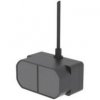Snowbirdxx
Well-Known Member
The LIDAR altimeter is build and works.
Weight 130 g thats 1/4 lb the box is about double the size of a cigarette box, but could be made smaller.
I have the Husky parked on a lift, so another plane can be hangared below it. That lift is ideal for testing and setting the sensor offset.
The LIDAR Sensor ( Benewake Mini TF Plus ) starts working at 60 ft and counts down to 0. Measurement is taken 20 times per seconds
Accuracy measured on the lift is 1" It is placed on the bulkhead of the bungeecompartment. The Geardoor is cut out to allow the sensor to look down.
The displayis on top of the dash between the leather lip and the top panel and displays wheel bottom distance in cm above ground. In addition there is an audio card connected to the Arduino computer which calls out the altitude. That signal goes into the AUX in plug.
Switching the LIDAR Alt on, on final , the display shows dashes. When approaching 60 ft the call is 20 meters)
The calls are continuos scrolling down. When approaching 6 ft the calls are in cm. It is easy to fly above the runway with a 10 call, wheels are then 3.5 inch off the ground. Calls and voice can be configured individually.
Offset when using differen tires can be done easy.
The guy who did the programming is offering the program for free. Building instructions can be supplied.
More testing today on grass.
When touching the concrete the display blanks and no more calls. When on the ground sound of clapping hands from passengers could be created or a nice female voice saying " You just touched...."
The pic shows the box with the Arduino computer and the sound card. Second pic is the LIDAR Sensor
Weight 130 g thats 1/4 lb the box is about double the size of a cigarette box, but could be made smaller.
I have the Husky parked on a lift, so another plane can be hangared below it. That lift is ideal for testing and setting the sensor offset.
The LIDAR Sensor ( Benewake Mini TF Plus ) starts working at 60 ft and counts down to 0. Measurement is taken 20 times per seconds
Accuracy measured on the lift is 1" It is placed on the bulkhead of the bungeecompartment. The Geardoor is cut out to allow the sensor to look down.
The displayis on top of the dash between the leather lip and the top panel and displays wheel bottom distance in cm above ground. In addition there is an audio card connected to the Arduino computer which calls out the altitude. That signal goes into the AUX in plug.
Switching the LIDAR Alt on, on final , the display shows dashes. When approaching 60 ft the call is 20 meters)
The calls are continuos scrolling down. When approaching 6 ft the calls are in cm. It is easy to fly above the runway with a 10 call, wheels are then 3.5 inch off the ground. Calls and voice can be configured individually.
Offset when using differen tires can be done easy.
The guy who did the programming is offering the program for free. Building instructions can be supplied.
More testing today on grass.
When touching the concrete the display blanks and no more calls. When on the ground sound of clapping hands from passengers could be created or a nice female voice saying " You just touched...."
The pic shows the box with the Arduino computer and the sound card. Second pic is the LIDAR Sensor
Attachments
Last edited:




